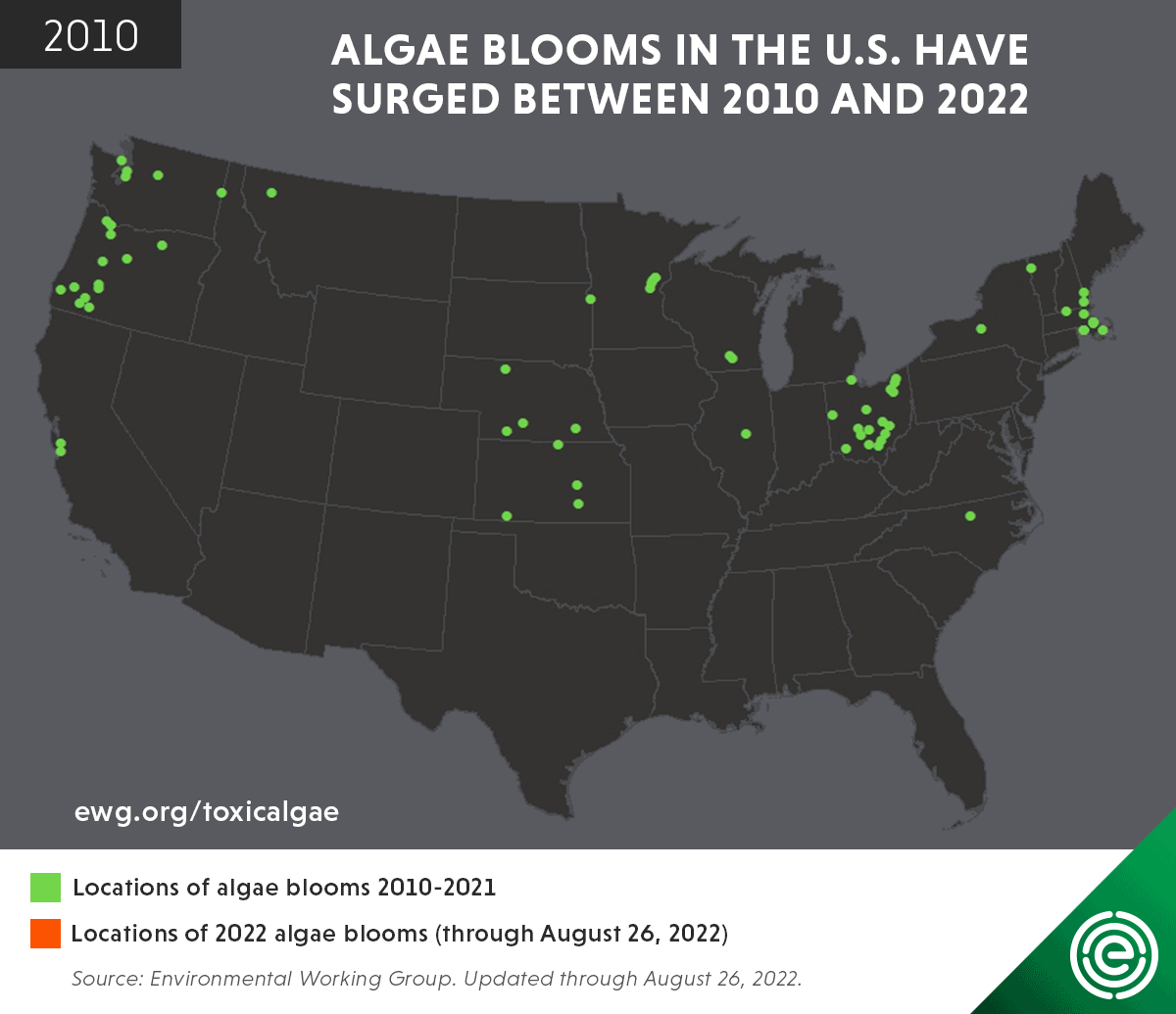
Summer is in full swing, with families heading to lakes and other bodies of water, and that means it’s also the peak season for harmful algae blooms.
Toxic algae blooms are a growing problem, polluting waterways across the U.S. They thrive when water is warmer, usually from May through October. But they can appear any time, and out-of-season outbreaks have become more common in recent years. As the climate crisis increases temperatures and the number of extreme rain events, they will continue to become more frequent and ubiquitous.
Toxic algae blooms appear when nutrients from farm fertilizer and manure run off into rivers and streams and other bodies of water, triggering the growth of microscopic single-celled organisms. The blooms are actually cyanobacteria but widely referred to as algae. Blooms often have a rotten smell and resemble spilled blue-green paint or split-pea soup.
Not all blooms are toxic, but those that are produce toxins called cyanotoxins. These substances can cause serious harm to human health. Short-term exposure through skin contact, inhalation or ingestion can cause sore throat, nausea, vomiting, diarrhea and liver damage. Long-term exposure can lead to sperm damage, liver failure and even cancer. Newer studies also show exposure to cyanotoxins may increase a person’s risk of developing the progressive degenerative disease known as ALS.
People are usually exposed to these toxins through swimming or playing in polluted water. And newer research shows toxins can also be airborne, posing risks even for those who just sit on a beach or walk near water.
It is impossible to tell if a bloom is toxic by looking at it, so if you see or smell signs of an algae bloom, try to avoid getting in, or even going near, the water, in case it is toxic.
No one knows exactly how many Americans are sickened by toxic algae each year. But a 2021 study by the Centers for Disease Control and Prevention reported that harmful algae blooms caused 321 emergency room visits over three years.
The blooms can also be hazardous to pets. In the summer of 2020, six dogs died after exposure to toxic algae blooms, including two puppies. Such stories have become a regular feature of the summer.
Toxic algae blooms have also caused massive fish die-offs and harmed other marine life, which can devastate local economies that rely on commercial fishing, tourism and recreational activities such as swimming and boating.
In 2019, all of Mississippi’s beaches were forced to close for the summer because of an algae bloom caused by agricultural contamination in the Mississippi River. The pollution was the result of heavy rainfall and flooding in the Upper Midwest that led the Army Corps of Engineers to open up the Bonnet Carré Spillway to release water.
No government entity tracks all toxic algae blooms nationwide. A 2020 EWG report showed problems with inadequate monitoring and public notification of potentially dangerous water contamination from toxic algae and fecal bacteria like E. coli in recreational areas across the U.S.
EWG helps fill this information gap by tracking news reports of algae outbreaks that have occurred in the U.S. since 2010. These reports are archived in our interactive map. Not every outbreak will be captured by a news report, but they are the best proxy we’ve found.

If you see algae that is bluish-green or looks like pea soup in a lake or other body of water, contact your local health department to let them know and have it tested for toxins. You can also reach out to local media to try to get coverage of the issue.
For further updates, keep an eye on our algae bloom news report map, which we’ll update throughout the summer, typically every two weeks.
Other resources about toxic algae blooms:
- National Oceanic and Atmospheric Administration’s Harmful Algal Blooms website.
- Bowling Green State University’s Great Lakes Center for Fresh Waters and Human Health.
- The Centers for Disease Control and Prevention’s Harmful Algal Bloom–Associated Illnesses page.



